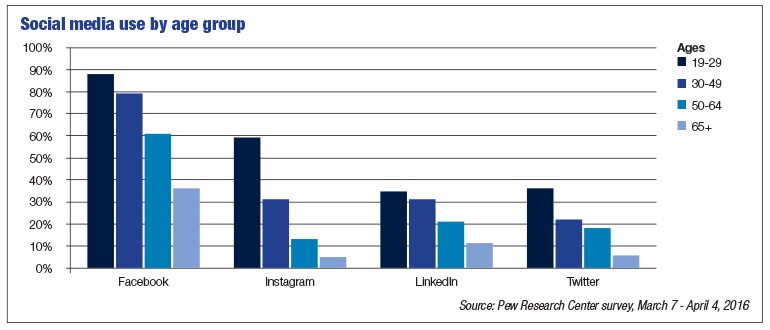With nearly seven in 10 American adults using social media, there are clear opportunities for businesses to take advantage of new ways to connect with customers and clients.
Not only has the use of social media skyrocketed – when the Pew Research Center began tracking adoption in 2005, it was 5 percent; now, it’s 69 percent – so, too, have the number of platforms and options. While Facebook dominates the market, other platforms, like Twitter, LinkedIn, Instagram and Snapchat, all have potential roles to play in social media strategies at corporate events.
With a plethora of platforms and new features, sometimes the hardest part is deciding what not to do, said Marc Whitney, account supervisor at Brookfield-based public relations and marketing firm The Ritterbusch Group.
“There’s a finite amount of time,” he said of events.

Whitney tells clients to focus on their message and audience. If the goal is to drive awareness about the company, the messages should be kept broad. If the goal is to target specific clients, the message needs to be tightly focused around specific product lines, offerings or pages on the company website.
“That conversation needs to take place ahead of time so that you’re making the best use of your time when you’re on site,” Whitney said.
Social media also doesn’t have to wait until the day the event starts. Joe Martinez, senior manager, paid media and community at Milwaukee-based digital marketing agency Granular, said creating a Facebook event or using the site’s paid advertising can help drive attendance at events. The ability to specifically target certain areas or interest groups is among the best features of the paid advertising option.
“We usually use more wider interest categories to promote ahead of time,” Martinez said.
After casting a wider net and generating some traffic, Martinez said he switches to a more targeted message. That means layering interests with very specific geographic areas. He’ll also create a different set of ads closer to the event to create urgency, including some that stress the limited number of seats available or days left to register. Updating those ads on a daily basis can keep them from getting stale, he said.
At the event itself, there are plenty of options for companies to increase their engagement with attendees. Ideas for each platform include:
- Twitter: Companies should create a unique hashtag to promote the event ahead of time and then use it on all posts during the event and to gather user-generated content, said Amanda Wambold, senior social media strategist at Waukesha-based branding agency z2. She also said Twitter provides an opportunity to live-tweet photos, quotes from speakers or behind-the-scenes information. She suggested mentioning specific companies or individuals who will be at the event. Whitney said it’s a good idea to tweet out a booth number so clients can find you at trade shows.
- Facebook: Whitney said Facebook works particularly well for companies looking for consumer recognition, with many friends and family engaging on the platform. Wambold suggested using Facebook Live for question-and-answer sessions, product demos and launches, speeches and interviews.
“Live video also allows viewers to ask questions directly and offers the opportunity for your company to answer those questions in live format, or respond to the comments later on,” she said.
Whitney cautioned that if you’re using live video at an event run by someone else, it is a good idea to check if there are any restrictions on its use beforehand. - Instagram: The platform falls into the “pretty pictures category,” Whitney said, adding “there’s absolutely a place for that.” Wambold said it also presents an opportunity for live video or to create Instagram Stories to show brief behind-the-scenes videos.
- LinkedIn: The networking and job searching site is the most business-oriented of the platforms. Whitney said it is a good place for thought leadership and the “why” of what a company does.
- Snapchat: Geofilters, overlays that can only be accessed in certain locations at specific times, offer a great opportunity for events, Wambold said, noting companies can incorporate a brand logo or trademark for attendees to use. But Martinez and Whitney cautioned that it works best at larger events and those that skew toward a younger demographic.
“It all depends on who your audience is,” Martinez said.
One option that works at events across a number of platforms is to run contests, Martinez and Wambold said. The idea is to pick a winner from among those who engage with your brand on a particular platform. It could be for the best photo from the event, best takeaway, a random winner from among those who shared or commented on a post, or those who answered a question.
Whitney said it is important to be strategic and to realize the amount of power those on the receiving end of a message now have.
“Engage with your audience and ask them how they want to be communicated with,” he said.
“It always comes down to knowing who your audience is and that’s something that’s forgotten about,” Martinez said.
Whitney also said it is important to realize a corporate event wouldn’t take place without attendees and everything doesn’t have to be about social media.
“There is something to be said for human contact,” he said.